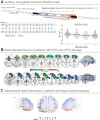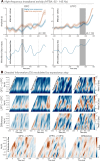This is a preprint.
Predictive encoding of auditory sequences in the human prefrontal cortex
- PMID: 40894738
- PMCID: PMC12393564
- DOI: 10.1101/2025.08.22.671264
Predictive encoding of auditory sequences in the human prefrontal cortex
Abstract
Humans extract regularities from the environment to form expectations that guide perception and optimize behavior. Although the prefrontal cortex (PFC) is central to this process, the relative contributions of orbitofrontal (OFC) and lateral PFC (LPFC) remain unclear. Here, we show that the brain tracks sound regularities in an auditory deviance detection task to predict when a target deviant will occur. Intracranial EEG in epilepsy patients reveals prefrontal engagement, with earlier expectancy-related modulation in OFC and later modulation in LPFC. Connectivity analyses indicate bidirectional and asymmetrical expectancy-related information exchange between the two areas, with a first lead by OFC, consistent with its role in initiating predictive encoding. Converging causal evidence shows that OFC lesions abolish sensitivity to expectancy, whereas LPFC lesions yield only modest effects not significantly different from controls. Together, these results provide electrophysiological and causal evidence for distinct, temporally organized contributions of prefrontal subregions to predictive processing.
Keywords: Contingent Negative Variation (CNV); EEG; High-Frequency Broadband Activity (HFBA); SEEG; anticipation; auditory perception; deviance detection; expectation; frontal lobe lesion; lateral prefrontal cortex; orbitofrontal cortex; prediction.
Conflict of interest statement
Competing interests The authors declare no competing interests.
Figures



Similar articles
-
Short-Term Memory Impairment.2024 Jun 8. In: StatPearls [Internet]. Treasure Island (FL): StatPearls Publishing; 2025 Jan–. 2024 Jun 8. In: StatPearls [Internet]. Treasure Island (FL): StatPearls Publishing; 2025 Jan–. PMID: 31424720 Free Books & Documents.
-
Orbitofrontal cortex modulates auditory cortical sensitivity and sound perception in Mongolian gerbils.Curr Biol. 2024 Aug 5;34(15):3354-3366.e6. doi: 10.1016/j.cub.2024.06.036. Epub 2024 Jul 11. Curr Biol. 2024. PMID: 38996534 Free PMC article.
-
Prescription of Controlled Substances: Benefits and Risks.2025 Jul 6. In: StatPearls [Internet]. Treasure Island (FL): StatPearls Publishing; 2025 Jan–. 2025 Jul 6. In: StatPearls [Internet]. Treasure Island (FL): StatPearls Publishing; 2025 Jan–. PMID: 30726003 Free Books & Documents.
-
Nivolumab for adults with Hodgkin's lymphoma (a rapid review using the software RobotReviewer).Cochrane Database Syst Rev. 2018 Jul 12;7(7):CD012556. doi: 10.1002/14651858.CD012556.pub2. Cochrane Database Syst Rev. 2018. PMID: 30001476 Free PMC article.
-
Intravenous magnesium sulphate and sotalol for prevention of atrial fibrillation after coronary artery bypass surgery: a systematic review and economic evaluation.Health Technol Assess. 2008 Jun;12(28):iii-iv, ix-95. doi: 10.3310/hta12280. Health Technol Assess. 2008. PMID: 18547499
References
-
- Rao RP, Ballard DH. Predictive coding in the visual cortex: a functional interpretation of some extra-classical receptive-field effects. Nature neuroscience. 1999;2(1):79–87. - PubMed
-
- Clark A. Whatever next? Predictive brains, situated agents, and the future of cognitive science. Behavioral and brain sciences. 2013;36(3):181–204. - PubMed
-
- Friston K. The free-energy principle: a unified brain theory? Nature reviews neuroscience. 2010;11(2):127–138. - PubMed
Publication types
LinkOut - more resources
Full Text Sources
Miscellaneous
